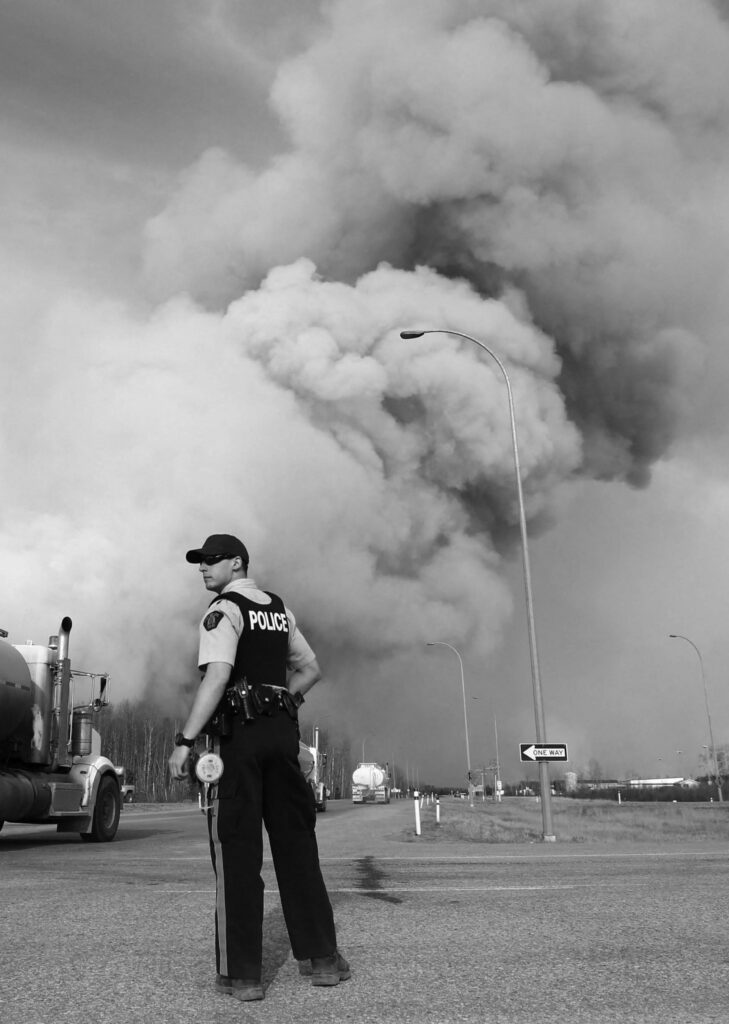You could say that John Vaillant benefited from a lucky coincidence when the release this spring of his book on climate change, fire, and the near destruction of Fort McMurray, Alberta, in 2016 coincided with smoke blanketing the media capitals of Canada and the United States. But that wouldn’t just be cynical; it would be wrong. No coincidence, lucky or otherwise, was necessary, because over the past decade, major forest fires have become a feature of virtually every summer and spring.
Vaillant’s previous non-fiction books focused on high-drama conflicts that illustrated aspects of humanity’s impact on the natural world. In The Golden Spruce: A True Story of Myth, Madness, and Greed, from 2005, he used the bizarre protest-killing of a mutant spruce tree in Haida Gwaii, British Columbia, to tell a larger story about destruction of West Coast forests. In The Tiger: A True Story of Vengeance and Survival, from 2010, he focused on a showdown between a hunter and a man-eating Siberian cat in the context of habitat destruction.
He continues with that approach in Fire Weather, which is almost two books in one. Book one has drama galore. It’s the hour-by-hour story of McMurray Wild Fire 009 — or MWF-009 — which was spotted southwest of the city on May 1, 2016. Within days, it forced the evacuation of 90,000 people. Vaillant takes readers through the desperate block-by-block battle as the inferno razed entire neighbourhoods and nearly burned the entire community off the map. To do so, he draws from dozens of interviews with firefighters — professional and volunteer — and residents who fled for their lives and returned to find all the physical evidence of those lives reduced to ash and twisted metal. In this respect, Fire Weather reads like an outdoor-adventure epic, along the lines of Jon Krakauer’s Into Thin Air or Sebastian Junger’s The Perfect Storm. Given the at times military feel of Fire Weather, with surprise attacks on multiple fronts and desperate tactics of exhausted firefighters calling in highly unusual urban air strikes by water bombers, an equally apt comparison might be to Mark Bowden’s Black Hawk Down.

The hour-by-hour story of devastation.
Cole Burston; Getty Images
The other Fire Weather is a history of humanity’s relationship with and understanding of combustion. In this second book, Vaillant discusses the nature of fire, shows how the effects of increased burning have been understood by science since the nineteenth century, and demonstrates the growing severity of conflagrations brought on by heat waves and droughts deepened by climate change.
The Fort McMurray disaster wasn’t just the scene of the biggest urban fire in North America or the largest fire evacuation in North American history. It was also the perfect symbol of the catastrophe that humanity has created through the consumption of fossil fuels. Fort Mac is, after all, an instant city created by our appetite for oil. And not just any oil: the synthetic crude produced by refining tarry bitumen is the most carbon-intensive oil in the world, requiring the burning of mind-boggling amounts of natural gas to liberate it from deep below ground and then to separate usable hydrocarbons from sandy gunk. Like the unsinkable Titanic hitting that iceberg, a burning Fort McMurray was instantly seen by many as a monument to technological hubris.
Even if you think you know something about fire (long ago, as a summer park interpreter, I wrote an amphitheatre show on its role in the life of the forest), Fire Weather contains plenty of material that will blow your mind (it did mine). In one section, Vaillant discusses the power released by a forest fire, which is measured in kilowatts per metre — that is, energy released for each metre of the burning front. At 1,000 kilowatts per metre, ground crews can manage a blaze with hoses and shovels. Above 2,000, it may be a challenge for water bombers. At 10,000, it’s totally out of control. In 2001, a record-breaking forest fire in northern Alberta, known as the Chisholm fire, hit 225,000 kilowatts per metre. How powerful is that? Vaillant cites a research paper showing that at its peak, the Chisholm fire released four times as much energy as Little Boy — the atomic bomb dropped on Hiroshima, Japan — every minute.
If you can’t get your mind around that kind of force, you’re not alone. As Vaillant argues, even professionals were unable to anticipate it until they met it face to face. As he notes, quoting The 9/11 Commission Report, “The most important failure was one of imagination.”
As the flames approached town, people in Fort McMurray simply failed to imagine how bad the situation could get. The fire had been burning out of control along the nearby Horse River, and the forecast for heat and wind was no secret. The temperature reached the 30s, 15 degrees above normal and 6 above the record for that day; the humidity was 15 percent, which Vaillant notes is more typical of Death Valley in summer than northern Alberta in spring. Five years before, a springtime fire had destroyed a third of the town of Slave Lake, just a few hundred kilometres southwest. But in Fort McMurray on May 3, people went about their business, dropping kids off at school and going to work. Time-stamped photos show a massive cloud of smoke bearing down on the city in the early afternoon, when still no evacuation order had been given.
McMurrians aren’t uniquely blind to disaster. Vaillant describes the Lucretius Problem, a concept the statistician and risk analyst Nassim Taleb named after Titus Lucretius Carus. Two millennia ago, the Roman poet wrote in De Rerum Natura (On the Nature of Things), “Any river is huge if it be the greatest man has seen / who has seen no greater before.” In other words, an individual’s understanding of what “hot” and “dry” and “fire hazard” mean will be limited by the heat waves and droughts in their own experience. Climate change is making these and other weather phenomena more extreme than ever, but it’s also increasingly difficult to imagine future catastrophic conditions.
When MWF-009 hit the city and the battle began in earnest, fighters were hampered by a number of factors related to modern urban living as practised in this urban outpost in the forest. In a municipality full of highly paid mechanics, welders, equipment operators, and other skilled blue-collar workers, many garages and driveways were packed with motorcycles, snowmobiles, powerboats, and classic cars. “This deep allegiance to the internal combustion engine posed a major problem,” Vaillant writes. “Residents owned so many vehicles, recreational and otherwise, that it was impossible to drive them all out.” Left behind, many of these vehicles became bombs waiting to be detonated, along with the tanks of welding gas in the garages of serious do-it-yourselfers and the propane barbecue tanks on nearly every deck and balcony.
Contributing further to the disaster was the way many modern homes are built and furnished. Vinyl siding, asphalt shingles, laminate flooring and countertops, and furniture made from hydrocarbon-based synthetics contributed to the speed of the inferno. Vaillant cites a 2005 study by Underwriters Laboratories in which fires were set in a pair of model rooms: one furnished with old-style products made of wood and natural fibres and the other full of modern synthetics. In a simulation involving a knocked-over candle, the entire modern room burst into flames within four minutes, as gases emitted by the heated furnishings exploded in a flashover. The “legacy” room took another twenty-five minutes to reach a similar point. As a result of the intense heat of the Fort McMurray fire and the explosive power of the gases produced by the homes, it was taking just five minutes to destroy a single house.
Worse still, the design of the city, with neighbourhoods surrounded by boreal forest, gave the fire a pathway. (When I started my newspaper career in the 1980s, I lived in Beacon Hill, which was reduced to cracked concrete foundations.) This is not an urban design phenomenon unique to Fort McMurray. Across forested parts of Canada and the United States, what’s been termed the wildland-urban interface is both highly desirable among homebuyers and the site of potential disaster. “It is a beautiful place to live,” Valliant writes, “until it goes feral.”
When Vaillant shifts his focus beyond Fort McMurray, he shows how the Lucretius Problem still hampers our thinking. When MWF-009 was the worst we’d seen, it was the worst we could imagine. But conditions just kept deteriorating. “If twenty-first-century fire has taught us anything,” he writes, “it’s that there is no top end.” Since 2016, there have been record-breaking fire seasons in Australia (in 2020), record-breaking temperatures in Lytton, British Columbia (in 2021), and “worst air in the world” alerts in major cities across western North America. This year, such alerts were issued for Toronto and New York City.
MWF-009 and more recent fires have spawned weather anomalies that “sound more like details from Old Testament or Greek mythology than events reported from one of the twenty-first century’s wealthiest industrial centers.” In Fort McMurray, the anomaly in question was a fire-borne thunderhead, known as a pyrocumulonimbus cloud, which spewed particulate matter and carbon dioxide into the upper atmosphere. In the years since, even hotter fires in California and Australia have produced tornadoes capable of launching vehicles into the air.
It’s not as if we weren’t warned. The effect of releasing so much carbon into the atmosphere has been known far longer than most of us realize. It was proposed by the physicist John Tyndall in 1859 — the same year as the drilling of Pennsylvania’s first oil well, which helped kick off the petroleum age. Almost a century later, in the run-up to the 1957 International Geophysical Year, the oceanographer Roger Revelle issued a warning to the United States Congress that the burning of coal, oil, and natural gas threatened to return the planet to the atmospheric conditions of 100 million years ago. Weather data already showed that the climate had been warming since about 1900.
Vaillant writes about encouraging steps that may point the way forward: liability lawsuits against the fossil fuel industry, banks pulling back from financing oil and gas projects, the insurance industry taking action to prevent multi-billion-dollar claims. We’ll probably learn soon whether it’s all too little, too late.
If we’ve known about climate change for a while, why has action taken so long? Vaillant points to greed as a central factor: after absorbing the science of climate change, the oil industry responded with campaigns of propaganda and misdirection. But a larger factor, surely, is that, at the individual level, fossil fuels make life immeasurably better. Vaillant paints a picture of a driver barrelling down the highway at a hundred kilometres an hour in a Chevy Silverado rated at 600 horsepower, toasty warm in the midst of Canadian winter: “Prior to the Petrocene Age, only a king or a pharaoh could have summoned such power, and its equivalent would have required hundreds of enslaved people and draft animals. Today, with cheap and plentiful oil at our disposal, everyone’s an emperor.”
Even when we know that as a species we must stop living like emperors, it’s awfully tempting to respond with “You first.”
Bob Armstrong is the author of Prodigies, an award-winning Western, and, since 2002, the speech writer for Manitoba’s lieutenant-governor.

